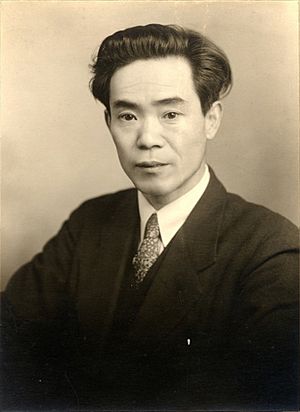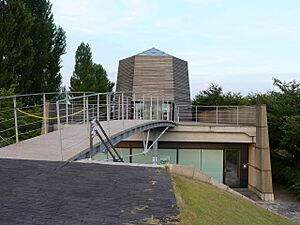Ukichiro Nakaya facts for kids
Quick facts for kids
Ukichiro Nakaya
|
|
|---|---|

Nakaya in 1946
|
|
| Born | July 4, 1900 |
| Died | April 11, 1962 (aged 61) |
| Alma mater | University of Tokyo King's College London |
| Known for | Artificial snowflakes |
| Scientific career | |
| Fields | Physics |
Ukichiro Nakaya (中谷 宇吉郎, Nakaya Ukichirō, July 4, 1900 – April 11, 1962) was a Japanese physicist and science writer. He was famous for his work on glaciology (the study of ice and glaciers) and how things behave in very cold temperatures. He is known for being the first person to create artificial snowflakes in a lab.
Contents
Life and Discoveries
Ukichiro Nakaya was born in Japan, near some hot springs in a place called Kaga. This area was famous for its snow, which later became his life's work.
When he was young, his father wanted him to be a potter. But Nakaya was more interested in physics, the study of how the world works. He was inspired by ideas about how planets form and by other scientists.
He studied experimental physics at the University of Tokyo and graduated in 1925. After that, he became a research assistant. He also studied in London for a couple of years, looking at special types of X-rays.
In 1930, Nakaya became a professor at Hokkaido University in Japan. This university had very little equipment for physics, but it had something amazing: an endless supply of natural snow! So, Nakaya decided to study snow crystals.
He took over 3,000 photos of natural snow crystals and sorted them into different types. This helped him understand their shapes.
Making Snowflakes in the Lab
In 1935, Nakaya opened the Low Temperature Science Laboratory. He wanted to create snow crystals himself. It was a tough challenge! He tried to grow ice crystals using cotton string, but they didn't look like snowflakes.
One day, he found a perfect snow crystal on a rabbit fur coat in his lab. This was a big clue! He realized that rabbit fur was much better for growing snow crystals than cotton.
Finally, on March 12, 1936, after three years of trying, he made the first artificial snow crystal! He used a single rabbit hair in his special lab equipment. This was a huge breakthrough in science.
Nakaya kept studying snow crystals. He figured out how their different patterns form in nature. He even created a special diagram, called the Nakaya Diagram, which shows how temperature and moisture affect the shape of snowflakes.
Later Work and Honors
After his snowflake discoveries, Nakaya also studied how frost affects the ground. This led to a new lab for agricultural physics. In 1941, he won a major award, the Imperial Prize of the Japan Academy, for his work on snow crystals.
During World War II, he helped study how to prevent ice from forming on airplanes. After the war, he continued to research how snowmelt affects rivers and floods.
Nakaya loved doing research outdoors, not just in the lab. He traveled to places like Mauna Loa in Hawaii and even an ice island in the Arctic to study ice. He also visited the United States and Canada to share his knowledge. From 1952 to 1954, he worked as a research fellow in the US, studying how sunlight affects ice crystals.
In 1954, he published a famous book called Snow Crystals: Natural and Artificial. This book showed all his research and amazing photos of snowflakes. Even today, it's a classic book for anyone studying snow.
He also visited Greenland several times to study its huge ice cap.
Ukichiro Nakaya passed away in 1962. Because of his important work, a group of islands in Antarctica was named the "Nakaya Islands" after him. An asteroid in space, 10152 Ukichiro, is also named in his honor.
His amazing achievement is remembered today by a special hexagonal stone monument at Hokkaido University, where his lab once stood.
Science for Everyone
Ukichiro Nakaya wasn't just a scientist; he was also a great writer who loved to explain science to everyone. He wrote many essays on topics from snow and earth science to how science works.
He also helped create documentary films and radio shows. He believed that science should be easy for everyone to understand.
His most famous quote is: "Snowflakes are letters sent from heaven." He used this idea in his films and books, showing how beautiful and mysterious nature can be.
Personal Life
Nakaya was married twice and had three daughters. One of his daughters, Fujiko Nakaya, became a famous artist known for her "fog sculptures," which are like clouds of mist.
In his free time, Nakaya was also a talented artist, creating beautiful Japanese ink paintings called sumi-e.
See also
- Egg of Li Chun


